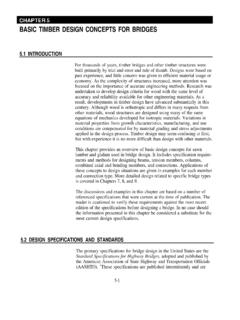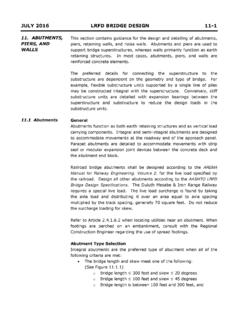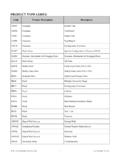Transcription of PROPERTIES OF WOOD AND STRUCTURAL WOOD …
1 PROPERTIES OF WOOD AND STRUCTURAL WOOD PRODUCTS INTRODUCTION Wood differs from other construction materials because it is produced in a living tree. As a result, wood possesses material PROPERTIES that may be significantly different from other materials normally encountered in STRUCTURAL design. Although it is not necessary to have an in-depth knowl edge of wood anatomy and PROPERTIES , it is necessary for the engineer to have a general understanding of the PROPERTIES and characteristics that affect the strength and performance of wood in bridge applications. This includes not only the anatomical, physical, and mechanical PROPERTIES of wood as a material, but also the standards and practices related to the manufacture of STRUCTURAL wood products, such as sawn lumber and glulam. In the broadest terms, trees and their respective lumber are classified into two general classes, hardwoods and softwoods.
2 Hardwoods normally have broad leaves that are shed at the end of each growing season. Softwoods have needlelike leaves that normally remain green year round. The classi fication as hardwood or softwood has little to do with the comparative hardness of the wood. Several species of softwoods are harder than many low- to medium-density hardwoods. With few exceptions the STRUCTURAL wood products used in bridge applications throughout North America are manufactured primarily from softwoods. Although hardwoods are not widely used at this time, STRUCTURAL grading procedures for hardwoods have been developed recently, and their use is increasing in some regions of the country. This chapter discusses the structure of wood, its physical and mechanical PROPERTIES , and the manufacturing and grading processes for sawn lumber and glulam.
3 The scope of coverage is limited to softwood species, al though many of the general characteristics are applicable to hardwoods. Additional information on wood PROPERTIES and characteristics is given in references listed at the end of this chapter. STRUCTURE OF WOOD To fully understand and appreciate wood as a STRUCTURAL material, one must first understand wood anatomy and structure. This can be considered at two levels: the microstructure, which can be examined only with the aid of 3-1 a microscope, and the macrostructure, which is normally visible to the unaided eye. MICROSTRUCTURE The primary STRUCTURAL building block of wood is the wood cell, or tra cheid. When closely packed, these wood cells form a strong composite system that is often compared to a bundle of drinking straws (Figure 3-1). As a unit, the straws (wood cells) weigh very little, but if restrained from lateral buckling, they will support a substantial load in compression parallel to their longitudinal axis.
4 If the straws are loaded in compression perpendicular to their longitudinal axis, they will yield under relatively light loads. Using this analogy, it is easy to visualize the superior strength-to-weight ratio of a cellular composite such as wood. Yet, each individual wood cell is even more structurally advanced because it is actually a multilayered, filament-reinforced, closed-end tube rather than just a homogeneous, nonreinforced straw (Figure 3-2). MACROSTRUCTURE The cross section of a tree can be divided into three basic parts: bark, cambium, and wood (Figure 3-3). Bark is the exterior layer and is com posed of an outer layer of corky material with a thin inner layer of living Figure Simplified depiction of the structure of wood, comparing it to a bundle of thin-walled drinking straws. (A) Parallel to their longitudinal axis, the straws (wood cells) can support loads substantially greater than their weight.
5 (B) When loaded perpendicular to their longitudinal axis, the straws yield under much lower loads. 3-2 Figure Drawing of the magnified structure of a softwood. cells. It functions to protect the tree and to conduct nutrients. The cam bium is a thin, continuous ring of reproductive tissue located between the wood and the bark. It is the only portion of the tree where new wood and bark cells are formed and is usually only one to ten cells thick, depending on the season of the year. All material inside the cambium layer is wood, which conducts and stores nutrients and provides the tree with STRUCTURAL support. At the center of the wood, where tree growth began, is the pith or heart center. Wood is divided into two general classes, sapwood and heartwood. The sapwood consists of both active and inactive cells and is located on the outside of the tree, next to the cambium.
6 It functions primarily in food storage and the transport of sap. The radial thickness of sapwood is com monly 1-1/2 to 2 inches for most species, but it may be 3 to 6 inches thick for some species. Heartwood, which was once sapwood, is composed mostly of inactive cells that differ both chemically and physically from sapwood cells. The heartwood cells do not function in either food storage or sap transportation. In most species, the heartwood contains extractive 3-3 Figure Tree cross section showing elements of the macrostructure that are normally visible without magnification. substances that are deposited in the cell during the conversion from sap wood to heartwood. These deposits frequently give the heartwood a much darker color than sapwood; however, in several species the heartwood is not dark and looks virtually the same as sapwood.
7 The extractives also serve to make the heartwood of several species more resistant to attack by decay fungi and insects. Because all heartwood was once sapwood, there is generally little difference in their dry weight or strength. Growth in wood cells varies between cells that are formed early in the growing season, earlywood cells, and those formed late in the growing season, latewood cells. Earlywood cells are usually formed during the first or second month of the growing season and have relatively large cell cavities and thin walls. Latewood cells are formed later in the growing season and have smaller cell cavities and thicker walls. The contrast between the earlywood and latewood cells forms the characteristic growth rings common to most species (Figure 3-4). These growth rings vary in width, depending on species and site conditions. In many species of softwood, such as Douglas-fir and Southern Pine, there is a marked con trast between the earlywood and latewood, and growth rings are plainly visible.
8 In other species, such as spruces and true firs, the change from earlywood to latewood is less obvious, and rings are more difficult to see. Environmental conditions can also affect growth rings. Rings formed 3-4 Figure Cross section of a pine log showing growth rings. Light bands are earlywood, dark bands are latewood. A growth ring is composed of the earlywood ring and the latewood ring outside it. during short or dry seasons are narrower than those formed under more favorable growing conditions. PHYSICAL PROPERTIES OF WOOD Physical PROPERTIES describe the quantitative characteristics of wood and its behavior to external influences other than applied forces. Included are such PROPERTIES as moisture content, density, dimensional stability, thermal and pyrolytic (fire) PROPERTIES , natural durability, and chemical resistance.
9 Familiarity with physical PROPERTIES is important because those PROPERTIES can significantly influence the performance and strength of wood used in STRUCTURAL applications. 3-5 DIRECTIONAL PROPERTIES MOISTURE CONTENT Wood is an orthotropic material with unique and independent PROPERTIES in different directions. Because of the orientation of the wood fibers, and the manner in which a tree increases in diameter as it grows, PROPERTIES vary along three mutually perpendicular axes: longitudinal (L), radial (R), and tangential (T). The longitudinal axis is parallel to the grain direction, the radial axis is perpendicular to the grain direction and normal to the growth rings, and the tangential axis is perpendicular to the grain direction and tangent to the growth rings (Figure 3-5). Although wood PROPERTIES differ in each of these three directions, differences between the radial and tan gential directions are normally minor compared to their mutual differences with the longitudinal direction.
10 As a result, most wood PROPERTIES for STRUCTURAL applications are given only for directions parallel to grain (longitudinal) and perpendicular to grain (radial and tangential). Figure 3-5- The three principal axes of wood with respect to grain direction and growth rings. The moisture content of wood (MC) is defined as the weight of water in wood given as a percentage of ovendry weight: MC = moist weight _ ovendry weight x 100 percent (3-1)ovendry weight In living trees, water is required for growth and development, and water constitutes a major portion of green wood. Depending on the species and type of wood, the moisture content of living wood ranges from approxi mately 30 percent to more than 250 percent (two-and-a-half times the weight of the solid wood material). In most species, the moisture content of the sapwood is higher than that of the heartwood (Table 3-1).










